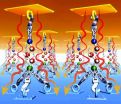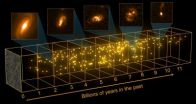(Press-News.org) This press release is available in French.
The researchers are focusing on analysing brain networks of brain-damaged comatose (non-traumatised) patients, a state where the individual is considered to be unconscious.
The authors of the study used an original graph theory-based methodology, where images were constructed using functional MRI data at rest and using robust statistical signal-processing methods. Local and overall effectiveness indices of functional brain networks were obtained for 17 brain-damaged patients and 20 healthy volunteers. Correlations in 417 brain regions were extracted to produce brain connection graphs using the statistically significant correlations.
Inserm unit 836 "Grenoble Institut des neurosciences", CNRS researchers from the "GIPSA lab" and from the Behavioural and Clinical Neuroscience Institute in Cambridge, in collaboration with clinical practitioners from the Strasbourg University Hospital Centre, have been able to highlight restructured brain networks in brain-damaged (non-traumatized) comatose patients.
Through comparisons with the healthy subjects, the results demonstrate that the overall cerebral connectivity is preserved in comatose patients. By analysing the connectivity at a local level, the authors of the study have observed that some brain regions ("hubs"), which are highly connected in healthy volunteers, are less well connected in comatose patients. Conversely, the less densely connected regions in the network in healthy subjects become "hubs" in comatose patients.
Brain imaging obtained from connectivity graphs
The connectivity graph method is used to summarize in a single image data acquired through MRI scanning. It translates the effectiveness of connections in a single region compared to all the others. By grouping the most interconnected regions, modules are revealed (each represented by a different colour). Patients and healthy volunteers both have different models in their spatial location, representing radical alterations to the brain connections.
According to current hypotheses, consciousness disorders in persistently comatose patients could be linked to disconnection phenomena between specific cortical regions, particularly the precuneus. The results of this study also point in this direction. "From an overall perspective, the topology of brain connections resists well to traumatism by reorganising the most interconnected regions in the network. It therefore seems that comas may be linked to changes in the location of "hubs" among the brain networks" suggests Chantal Delon Martin, an Inserm researcher.
An assessment of brain injury and comas
Patients with brain injury may go through various clinically-defined states: vegetative state that is characterized by the preserved sleep-wake cycle (eyes opening spontaneously, autonomous breathing, etc.); minimally conscious state where patients have partially preserved environmental consciousness (eye movement capacity, reaction to stimulation); locked in syndrome where the patient is paralysed but conscious (communication using eyes); brain death when the coma is irreversible flat line EEG, no blood flow).
Coma (from the Greek κῶμα kôma meaning "deep sleep") is one of the different states where self awareness and consciousness of the outside world is eradicated further to an accident (cerebral, cardiac, etc.). There are two coma phases: the "acute" coma phase (a few days after the accident) and the "chronic" phase (one month or more). Brain restructuring was observed by researchers during the "acute" phase, when it is not known which coma type the patient will develop.
Assessments of brain injuries in comatose patients are currently conducted through clinical examination, morphological MRI, evoked potentials and by SPECT (Single-photon emission computed tomography) or TEP (Positron emission tomography (PET). "The results of this study could help clinical practitioners in the difficult diagnosis process for comatose patients, since this method makes it possible to characterize each patient individually", conclude the researchers.
### END
The radical restructuring of brain networks in comatose patients
2012-12-04
ELSE PRESS RELEASES FROM THIS DATE:
Nature Materials study: Boosting heat transfer with nanoglue
2012-12-04
Troy, N.Y. – A team of interdisciplinary researchers at Rensselaer Polytechnic Institute has developed a new method for significantly increasing the heat transfer rate across two different materials. Results of the team's study, published in the journal Nature Materials, could enable new advances in cooling computer chips and lighting-emitting diode (LED) devices, collecting solar power, harvesting waste heat, and other applications.
By sandwiching a layer of ultrathin "nanoglue" between copper and silica, the research team demonstrated a four-fold increase in thermal ...
Fish oil helps heal bed sores of the critically ill
2012-12-04
Chock-full of Omega-3 fatty acids and antioxidants, fish oil can help lower blood pressure, reduce inflammation in the skin and joints, and promote healthy fetal development. Now a Tel Aviv University researcher has found that it has a positive effect on bedsores, too.
A common problem in critically ill patients, bedsores result from constant pressure on the skin and underlying tissue due to prolonged sitting or lying down. Painful and prone to infection, the pressure ulcers need to be healed, says Prof. Pierre Singer of the Sackler Faculty of Medicine. With Ph.D. candidate ...
Understanding anger, overcoming anxiety
2012-12-04
Montreal, December 4, 2012 – Anger is a powerful emotion with serious health consequences. A new study from Concordia University shows that for millions of individuals around the world who suffer from Generalized Anxiety Disorder (GAD), anger is more than an emotion; it's an agent that exacerbates their illness.
Concordia graduate student Sonya Deschênes investigated the subject after conducting a literature review for her PhD research, supervised by psychology professor Michel Dugas. While some of the studies she came across showed that anger and anxiety were linked, ...
Sunshine, biofuel and the tides, oh my!
2012-12-04
SAN FRANCISCO - Scientists from the Department of Energy's Pacific Northwest National Laboratory will present a variety of alternative energy-related research at the 2012 American Geophysical Union Fall Meeting, which runs Monday, Dec. 3 through Friday, Dec. 7 at the Moscone Convention Center in San Francisco. Topics to be discussed include improving solar power forecasting, measuring the resources needed to grow algae for biofuel and predicting the environmental impacts of ocean energy. Summaries of some of PNNL's noteworthy presentations are below.
Forecasting clouds ...
Herschel and Keck take census of the invisible Universe
2012-12-04
By combining the observing powers of ESA's Herschel space observatory and the ground-based Keck telescopes, astronomers have characterised hundreds of previously unseen starburst galaxies, revealing extraordinary high star-formation rates across the history of the Universe.
Starburst galaxies give birth to hundreds of solar masses' worth of stars each year in short-lived but intense events.
By comparison, our own Milky Way Galaxy on average produces the equivalent of only one Sun-like star per year.
Starburst galaxies generate so much starlight that they should outshine ...
Overprescribing of opioids impacts patient safety and public health
2012-12-04
A Viewpoint article published recently in the Journal of the American Medical Association suggests that the clinical practice of prescribing amphetamines, opioids, and benzodiazepines to treat chronic pain may be contributing to the increase in fatal drug overdoses and the likelihood that those drugs will be diverted to the illegal market. "Rethinking Opioid Prescribing to Protect Patient Safety and Public Health" was authored by Johns Hopkins Bloomberg School of Public Health researchers G. Caleb Alexander, MD, MS, and Daniel Webster, ScD, MPH, and Stefan P. Kruszewski, ...
Targeting neurotransmitter may help treat gastrointestinal conditions
2012-12-04
HERSHEY, Pa. -- Selective targeting of the neurotransmitter that differentially affects brain cells that control the two distinct functions of the pancreas may allow for new medication therapies for conditions like diabetes, dyspepsia and gastro-esophageal reflux, according to Penn State College of Medicine researchers.
"This study differs from what's been reported previously about brain neurons that control the gastrointestinal tract," said R. Alberto Travagli, professor, Department of Neural and Behavioral Sciences, and lead investigator. "It provides further support ...
Telecommuting increases work hours and blurs boundary between work and home, new study shows
2012-12-04
AUSTIN, Texas — With fluctuating gas prices and the increasing call for work-life balance, telecommuting has become an attractive option for busy professionals. Yet according to a new study from The University of Texas at Austin, for most employees who work remotely, telecommuting equates to working more hours.
The study, co-authored by Jennifer Glass, professor in the Department of Sociology and the Population Research Center, shows that most of the 30 percent of respondents who work from home add five to seven hours to their workweek compared with those who work exclusively ...
Infants learn to look and look to learn
2012-12-04
Researchers at the University of Iowa have documented an activity by infants that begins nearly from birth: They learn by taking inventory of the things they see.
In a new paper, the psychologists contend that infants create knowledge by looking at and learning about their surroundings. The activities should be viewed as intertwined, rather than considered separately, to fully appreciate how infants gain knowledge and how that knowledge is seared into memory.
"The link between looking and learning is much more intricate than what people have assumed," says John Spencer, ...
Improving chemotherapy effectiveness by acting on the immune system
2012-12-04
This press release is available in French. These results reveal how the immune system can then limit the effectiveness of some cancer chemotherapies. The researchers now intend to block the molecules responsible for negative immune system activation to increase the efficiency of chemotherapy. A clinical trial to test this hypothesis should begin very soon.
Chemotherapy is one of the most frequently used treatments to eliminate cancerous cells. These drugs kill all cells that are multiplying, or block their proliferation (for example, cells responsible for hair growth, ...


